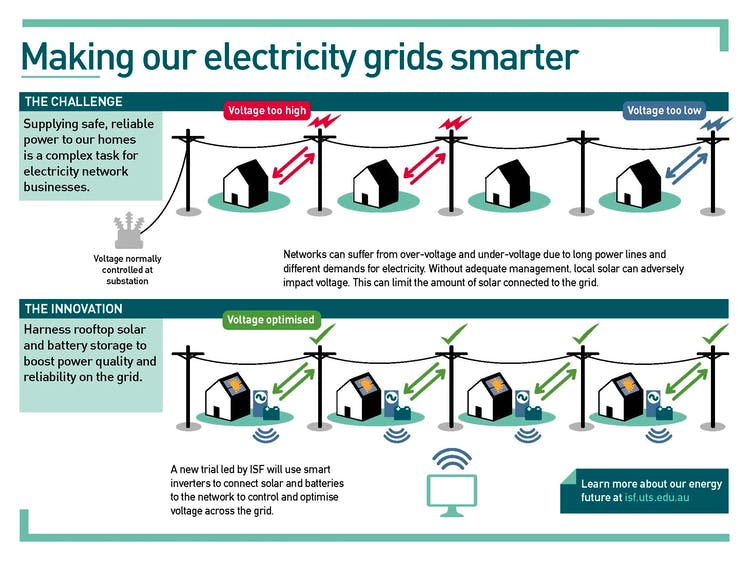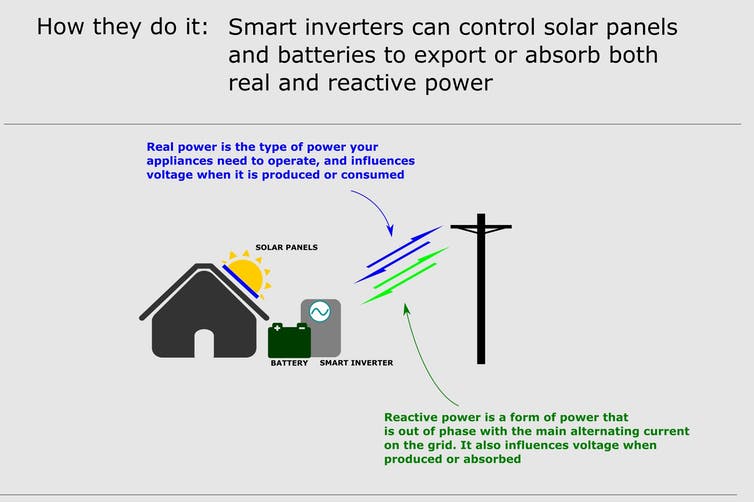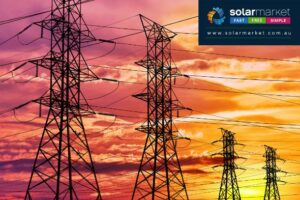Some commentators seem to be worried that our electricity networks are facing an impending voltage crisis, citing fears that renewables (rooftop solar panels in particular) will threaten the quality of our power supply.
These concerns hinge on the fact that solar panels and other domestic generators can push up voltages, potentially making it harder for network companies to maintain stability across the grid. But what is less well understood (and far less reported) is the massive potential for local generation to actually improve the quality of our power, rather than hinder it.
A new report from our Networks Renewed project aims to show how technologies such as “smart inverters” can help to manage voltage at the household scale, rather than at substations. This would improve the quality of our power and flip the potential problem of household renewables into a solution.
Why all the fuss about voltage?
Electricity from our power points should be at roughly 230 volts, without deviating too far above or below. It fluctuates throughout the day, depending on how much power is being used.
Here’s an analogy: think of water flowing through pipes. The power lines are the pipes themselves, and the voltage is like the water pressure in the pipes – that is, the amount of force pushing the water (or electricity) along. Using large amounts of power causes the voltage to drop, rather like when the washing machine comes on while you’re having a shower; all of a sudden the pressure drops because other appliances are using the water too.
Pressure is also affected by how close the appliance is to the source. For instance, if your washing machine and shower were connected right at the foot of the dam, instead of at the end of several miles of pipes, you could have them both switched on and not notice a drop in pressure.
For an electrical distribution system, this means that the houses farthest away from the substation are the most susceptible to sagging (lower) voltage when large amounts of power are being used.
Voltage management has always been an issue for grid operators, particularly in rural locations where the power lines are longer. Low voltage on long power lines often means dim and flickering lights for residents at the end of the line.
On the flip side, overvoltages can damage sensitive electronic equipment – a bit like when the water pressure pops your garden hose off the tap.
These fluctuations can become a problem for power companies when the voltage goes outside the allowable range.
How does solar power affect voltage?
Our electricity networks were not originally built for lots of local generation sources like rooftop solar panels or small wind turbines. Until recently, power has generally flowed only in one direction, from a large (usually coal-fired) power station to consumers.
The growing number of household solar panels on the network have changed this landscape and now power flows both ways. Solar panels can make managing the grid more complex, because the voltage rises where they are generating power.
A small voltage increase is not a problem when there is enough demand for electricity. But when nobody is home in the neighbourhood, the solar power might lift the voltage beyond the upper limit.
In this case, the circuit protectors in the generator will probably trip and the solar panels will be cut off, to protect the network. This also means that the household won’t have access to (or get paid for!) the solar power it is generating.
Any customer-owned generator can affect the voltage – including solar, batteries, or diesel generators. But we tend to hear about solar because it is by far the most popular means of local generation; Australia now has more than 1.5 million homes with rooftop solar, and that figure is rising rapidly.
While some people might see this as an issue, sometimes the solution lies in the problem itself. In this case, new solar systems can offer a much more sophisticated way to manage grid voltage.

How can solar become the solution?
Traditionally, voltage management solutions are fairly blunt, affecting tens or even hundreds of properties at a time, despite the fact that conditions might be quite different at each property. The equipment used – replete with technical-sounding names such as “on-load tap changers” and “line-drop compensators” – is expensive and is often located within transformers at substations. All of this electrical engineering kit adds to the cost of energy for customers.
However, new solar and battery systems now have the intelligence to manage voltage in a cheaper and more targeted way, through their “smart” inverters. These new technologies may provide the missing link to new renewable and reliable energy sources.
This is how it works: residential solar, batteries and other generators are connected to the grid through inverters that now have embedded IoT (internet of things) communications technology. These smart inverters allow the network to “talk” to the local generator and request support services, including through what’s called reactive power (see graphic below).
Reactive power can help to raise and lower the voltage on the network, improving the quality of our power including the voltage stability. For more technical detail see our newly released report on the potential for smart inverters to help manage the grid.

All this is only possible if network businesses are open to new, proactive ways of operating – as demonstrated by our Networks Renewed project partners United Energy in Victoria and Essential Energy in New South Wales.
This means a shift in thinking from the traditional passive customer model – we deliver energy to you! – to a more dynamic and collaborative one in which customers can actually help to manage the grid as well as using and generating power.
Sure, transitioning an entire energy system is no mean feat, but it offers an opportunity to build a better, more resilient electricity system that includes more renewable energy.
If we are smart, we will not need to trade off our climate impact with the dependability of our electricity system. We just need to be open to the new ways of solving old problems.
If you’re interested in finding out more, the Institute of Sustainable Futures is holding a public forum on Networks Renewed at UTS campus on Tuesday February 14 at 12:15-3:15 pm. For further information contact Dani Alexander.









